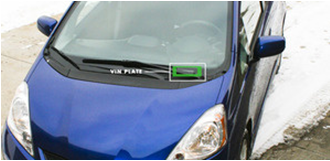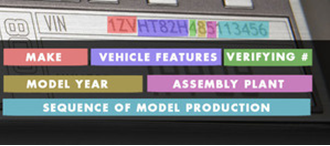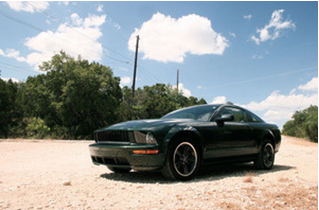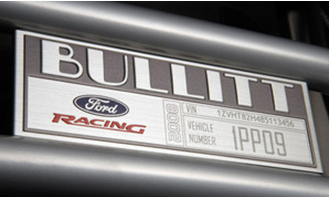Decoding a VIN
The Vehicle Identification Number program was initiated by the International Organization for Standardization (ISO) in 1980 as a way to standardize car serial numbers. Cars built before 1981 don’t follow a universal standard and thus require manufacturer-specific information to decode. Why was this worth the ISO’s time? Simple: The whole thing was created to ensure that no one car — make, model, production run, etc. — was ever passed off as another.
Decoding a VIN is an easy way to make sure that you don’t get ripped off in a purchase — either by buying a vehicle pretending to be something it isn’t, like a stock Mustang dressed up to be a special edition Cobra, or by purchasing a car with a salvage or rebuilt title.
Step One: Find It
 The vast majority of new cars have their VINs located under the front of the windshield and typically visible through a small, clear square within the tinted area. Depending on the year and price of the car you’re looking at, what’s there will vary: It could be a nicely stamped piece of aluminum, or it could be a cheap plastic tag. Both are usually riveted onto the dash in order to make replacement difficult. Limited-edition models or expensive sports cars may also have a special VIN plate located in the door sill or on the dash.
The vast majority of new cars have their VINs located under the front of the windshield and typically visible through a small, clear square within the tinted area. Depending on the year and price of the car you’re looking at, what’s there will vary: It could be a nicely stamped piece of aluminum, or it could be a cheap plastic tag. Both are usually riveted onto the dash in order to make replacement difficult. Limited-edition models or expensive sports cars may also have a special VIN plate located in the door sill or on the dash.
Step Two: Break It Down
 As you can see in the graphic on the left, the VIN is composed of six parts:
As you can see in the graphic on the left, the VIN is composed of six parts:
Make/Model: (Digits 1-3) This breaks out the vehicle’s make, model, and manufacturer.
Vehicle Attributes: (Digits 4-8) These digits identify the various features of the specific model — trim specifications, driveline options, etc.
Check Digit: (Digit 9) Determined through a complex mathematical formula that relates to the other numbers in the VIN; used to verify that the VIN itself is not fake.
Model Year: (Digit 10) Represents the vehicle’s model year, which is not to be confused with the year it was sold or delivered.
Assembly Plant: (Digit 11) An internal digit that shows where the car was built.
Sequence Of Model Production: (Digit 12-17) These digits indicate the order in which the vehicle left the assembly line. This is effectively the serial number.
NOTE: A VIN will never include the letters I, O, or Q because of their similarity to the numbers “1” and “0”
Step 3: Decoding The Make
We’re going to use the VIN 1ZVHT82H485113456 from the photo on previous page as the sample to work from. We won’t tell you what this vehicle is, but you should know more about it by the time we reach the end of the number.
Our first decoding challenge is to figure out who made this vehicle. This is found in the digits 1ZV. The first digit in the make code will always be the country of manufacture. There are numerous country codes, but the most common ones are:
- USA: 1, 4 or 5
- Canada: 2
- Mexico: 3
- Japan: J
- Korea: K
- England: S
- Germany: W
- Italy: Z
- Sweden: Y
- Australia: 6
- France: V
- Brazil: 9
Looking at our code, it’s clear we’re dealing with an American car or a foreign car built in America.
When we add the next two digits to the equation, we discover the manufacturer. The full three-digit code is called the World Manufacturer Identifier. There’s more to this than simply handing an "F" to Ford or a "G" to GM. For instance, "1GC" represents Chevrolet trucks, and "1G1" is for Chevy passenger cars.
It turns out that "1ZV" is the code for AutoAlliance International, a company building cars for both Mazda and Ford. This means our car is either a Ford or a Mazda product.
Step 4: Figuring Out the Features
More than just telling you what model of car you have, this section often describes the type of engine and platform the car uses. How this is used is based on the country and company in question, but most companies selling cars in North America have similar formats. Since we know our car is a Ford or a Mazda, it’s fairly easy to decode what HT82H means.
The first digit, H, is a safety code and indicates that the car has front and side airbags. Other digits include “B” for the use of active belts but no airbags. The letters “L” and “F” or “K” indicate different generations of airbags.
Digits five through seven, in this case T82, tell us what kind of vehicle this is. Using this handy guide to Ford VINs we know that Ford uses “T8_” for the Mustang coupe. Even more exciting, it’s a either a Mustang Bullitt, Coupe GT or Coupe Shelby GT. If someone is trying to sell you a Mustang and claims it’s a “GT” hardtop but its VIN says “T80,” they’re lying to you.
 The most important digit, if you’re trying to determine what engine the car has, is the eighth one. In this case, the digit H indicates that we have a car with Ford’s 4.6-liter modular V-8. If the digit was an “N” it would indicate a V-6 and we’d know something was fishy. If the code was an “S” we’d know we had a Coupe Shelby GT on our hands.
The most important digit, if you’re trying to determine what engine the car has, is the eighth one. In this case, the digit H indicates that we have a car with Ford’s 4.6-liter modular V-8. If the digit was an “N” it would indicate a V-6 and we’d know something was fishy. If the code was an “S” we’d know we had a Coupe Shelby GT on our hands.
Step 5: Using the Check Digit
Most companies use the ninth digit, always a number, as a check digit. Using a complex mathematical equation, they can determine if the product of multiplying all of the numbers and letters in the VIN besides the 9th digit, when divided by 11, has a remainder equal to the check digit. If it does, the VIN is real.
If you’re a total math nerd, you can follow these instructions. If you’re a little lazier, you can use this calculator to determine if your check digit is correct.
Step 6: Determining the Model Year
Since 1980, different countries have used slight variations of model years. Still, there’s a generally accepted format that most companies use for the 10th digit. If the car was built between 2001 and 2009, the digits 0-8 will appear here. Our vehicle’s 8 tells us that it’s a 2008 model-year car.
If the car in question was built between 1980 and 2000, the code will be “A-Y”, sequentially excluding the three letters not found in any VIN. For example, a car built in 1994 would have the code “R” and a car from 2000 would use “Y”. Starting in 2010, most manufacturers and vehicles reset to the letter “A”.
Step 7: Decoding Where it Was Built
The 11th digit is for identifying where the vehicle was made. There’s no set standard for this, so you need to consult a list of the company’s manufacturing facilities and VIN codes. These are almost all up on Wikipedia. The 5 in our sample VIN matches up to the AutoAlliance plant in Flat Rock, Michigan.
Step 8: The Sequence of Model Production
The final six digits indicate how far along into a given production run that the vehicle was built but, because some companies make a lot of a certain model, this isn’t necessarily a number. In the case of our Mustang, the digit is a number: 113456.
For most car owners, this number isn’t very significant. For special models, such as limited edition Corvettes or end-of-production vehicles, this can be the best way to determine if the vehicle is what it purports to be. Most Mustangs are produced on the same assembly line so, in this case, we can’t determine anything special about our car.
Step 9: Compare What The Number Shows To Your Vehicle
 When we zoom out, it’s clear that the car is a 2008 Ford Mustang Bullitt. Compare this to what is shown in the VIN number, and it appears that our car checks out.
When we zoom out, it’s clear that the car is a 2008 Ford Mustang Bullitt. Compare this to what is shown in the VIN number, and it appears that our car checks out.



